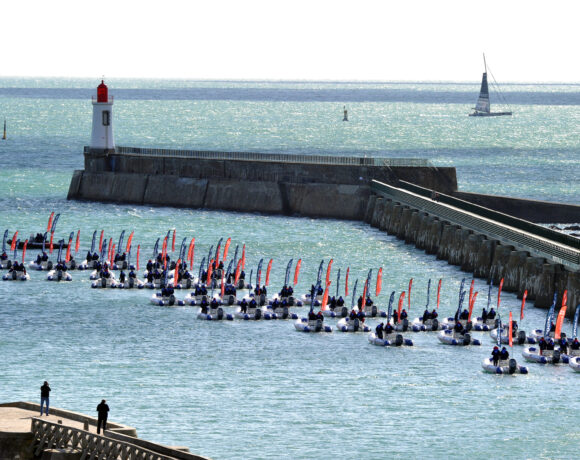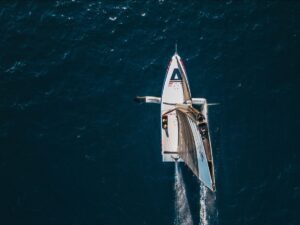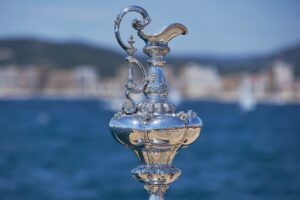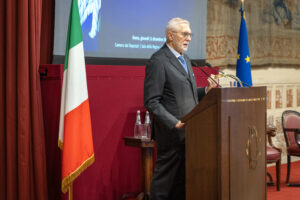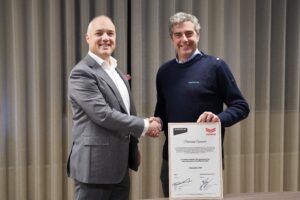The future of next Volvo Ocean Race? Which are selection criteria for port selection? The new boats? Volvo involvement? THese are only few questions made to Tom Touber (COO VOR) and Knut Forstad (CEO VOR) in order to better understand how managers have planned the future of ocean sailing.
TOM TOUBER
– What are the general criteria used for the host port selection from both a sports and a logistic point of view?
The most important one is of corse that we are sailing around the world and we need to have a good balance in the length of the legs, so first we chose the ports that are strategically placed on the route. Ideally a leg would be 3.000/4.000 miles, an offshore one can be longer, almost twice as long. Next of course is what you need in a port. You need the water to be deep, the VO65 has a bigger draft even than the old 70 and most marinas are not deep enough and we don’t like to be in an industrial port. The third is the commercial side and the geographical side: which countries we want to go in order to have an attractive race for all our commercial partners. Technically there are a couple more restrictions sailing around the world, the west Coast of the US is an interesting area but it would mean a big problem because you are too far away and you can’t get down anymore to the Southern Ocean and Cape Horn.
– How many cities bid? And how many did you visit personally?
We had 82 ports that were interested to host the race and we could only award 8 to 11 of the status. We used an external company to do all the negotiations for us and that reported back to us all the interest they had. I personally only visited the places that had issues to be handled or when a port was new. Of course I onlu go when we are further down in this process and we have to make sure that the basics are in other there so they will be able to deliver their commitments. This comes from the VVOR experience in the past, it is extremely important that we see the location with our own eyes, because even agencies or sponsors see thing from a different angle than we do.
– From a purely technical standpoint, what is needed for a location to become a good stopover (infrastructures, facilities, accessibility etc.)
The ideal port would be a fantastic city that everyone wants to visit, according to the Lonely Planet last year the best place to go would be Vancouver… What we also want is a natural arena, Gothenburgh for example has this feature. We also need to have a good, windy place with a solid 20 knots of breeze or more. One of the new ports, Recife has light winds in the morning but form 12 or 1pm there is solid trade winds which makes racing perfect, of course. And then the people… like the one we had last time in Itajaì, Brazil, where we had huge crowds and everyone was enthusiastic about the race. We need the locals to be engaged to have a good stopover.
– One of the new aspects of the 2014-15 edition is the “shared” shore team, did it make your job somewhat easier?
It makes it easier from a perspective that now we cam make agreements with the ports on all the facilities needed and have that under just one management. The benefits will show mostly when we will run the stopover, in the selection process id didn’t matter a lot. We have quite a big facility, the “common” shipyard needs to be close to the boats, it is a tent of 20×50 metres, quite a big one. During the stopovers it will make thing much easier because all the procedures, the boats’ movement, will be managed by Nick Bice (il responsabile dello shore team condiviso) and so we can plan the stopover much carefully. For the next race edition we even considered to have three sets but then we chose to have two leapfrogging them from one port to the other (like one in Alicante and one in Recife). Especially in the last part of the race when the boats get to Europe, the legs are so fast that even leapfrogging is not enough to have all the infrastructures in all the places. So we have to make a lot of calculations with Gonzalo Infante to make the legs a little bit longer to make the logistics easier to have the ships with all the things we need in time in the following location.
– Does the new boat, the OD65, also made things easier?
No, more difficult because unfortunately the designers made her deeper (deeper draft) and the size is almost the same. Everybody says 65 feet but in the end it is nearly 68. It is still al large boat, we can expect the logistics to be almost the same. We expect to have a good fleet of eight boats in the race and if you look at the last time, some ports struggled even to host six boats. On the other hand the VO65 concept has a lot of advantages because we are using system that we call “smart logistics”, completely different from the past and for example we will not have a spare mast for every boat sitting in Amsterdam or in Frankfrut airport but we will punt them in tubes in strategically chosen places around the world. For example one mast will be in Alicante, one in Recife, one in Auckland to avoid to have them flying very far. This will be much cheaper too, the operational cost of a campaign will really go down by 50%.
– Is there an local organizer in every port you deal with?
Yes, and this is very important because our race is completely different from Formula1 as the VOR is still Life at the Extreme so what we like to offer in every port is a big sports event but also a local experience so we like for example to have the American stopover in Newport to be as American as possible. There is al lot of elements that we bring in that are the same around the world /the In-port format, the Village) but everything can look different in the US, in China or in Brazil because we like also to have the flavour and the feeling of the stopover to be adapted to the local situation. This is part of the fun and the adventure around the world.
– How different it is to deal with a port that hosted the race before and a “debutant”?
Yes it’s harder to deal with a new port but it also depends on the sports experience the place has organizing other events. Newport for example has a huge experience in yacht racing and a lot of heritage so it’s harder going to Recife that despite being the fourth biggest town in Brazil has not such a great experience on the technical side. We have a dedicated port project manager in our staff here in Alicante to helpo the stopovers in the organization and to make it as effective as possible. But we are also open to new ideas, we’re just back from Recife where we saw their Carnival, they have 4.5 million people… they sure know how to organize that! Hpefully there will not be as much public in the VOR Race village or it’s going to be crazy.
– How do you manage the delicate balance between the marketing and the sports/sailing aspects of the selection?
In the edition we are working on it is absolutely not true that we are going where the money is. This is going to be one of the greatest races in the history because the balance between the long offshore, ocean legs, very good southern ocean sailing even more than in the previous ones and we need to face reality, there are new territories in our sport, there is a commercial side as well but is quite old fashioned to think that Europe or the US is the centre of the world. Sailing is also growing quickly in other parts of the planet, like in Brazil, in China or in the Middle East and you can’t ignore that. Is not only the money it is also the fact that there are more and more people starting to sail in those countries and the interest is growing. So, as long as we can go there, there is good sailing and the race benefits from growing economies we will do it.
KNUT FROSTAD
– How much work is involved in the host ports selection process
A lot, we start with a debrief, we already started before the start of the last race and the selection process began in January 2012. So it takes one full year, to run a tender process is complicatred. The guys that do it for us do it also for other sports events that are easier, for example for a golf tournament there is only to sort out the cities but we are going around the world so there is a huge amount of complexity. The complexity is how to select the locations, it has to be a sailing route but it has to match with the timing, the logistics, the public holidays, the weather and the season in the Southern oceans. It’s a big puzzle…
– Why did you choose to appoint an independent consultancy agency for the job
This is quite common, we did it first because we are too busy to do it during the race and we have to be ready in time. Secondly, in our experience, is quite important for the cities to have someone in between who is working both for them and for us. They can be completely neutral because their job is to get all the information on the table and come to us without us thinking what is the best way to sail there or other. It’s quite common in sports to have agencies like that because the organizers can only focus on the sports side and the one we use are specialised in sailing so they know what they are doing.
– How do you manage the delicate balance between the marketing and the sports/sailing aspects of the selection
It’s quite easy to us to do because we have a set of criteria the cities have to meet. We need to have acertain space, we need a good sail area, we need hotel accommodation, infrastructures, a marina. Then when the ports qualify for this criteria we have to look after the commercial side and the sailing side. The most important aspect for us is to make it a great race, and you judge that by measuring how successful a city is, how many people will follow the rac and what the city can bring to the race (local audience, more public, scenery…). People think that you may go for a sailing option or a commercial option, but it’s not true we have always tried to achieve both. And we would never go to a place you cannot sail to or where there is no wind or can’t have a good in-port race. Of course you can choose a shorter distance but I think that one of the big benefits of sailracing today is that you can sail almost everywhere where there is a waterfront, the ocean. If you think you can only go to the Southern ocean, to New Zealand for example, you are limiting the sport a lot. More, every sport today is loking for expanding it’s horizon because the world today communicates so much compared to 15 years ago. It’s important for the sport of sailing that we can go to other countries, sometimes it creates challenging routes to sail (like the Malacca Strait in China) but t the same time the weather conditions are interesting and varied. Some of the closest racing we had last time were in the new countries. It is not boring, the conditions are tough, difficult, challenging. It is a hard balance but we can say that it has to work for sponsors and for sailors, if we would ignore that the VOR would not be the same race.
– Do the interests of Volvo Corporation have a role in the process
Yes, because they are the owners of the event so if they would strongly disagree with the route they would make an objection. But at the same time Volvo has a very strategic role in the race and they really do believe in the importance of the sailing aspects. We go to places now, like Auckland, where there is not a very strong commercial interest for Volvo but they recognize it is important for the event and they actually promote the stopover. Newport or Lorient are sailing cities and they recognize it. I think it is a myth that a sponsor is contradictory to the sport because in fact Volvo are smarter that that. They would never enter a sport and try to change it, they understand they have to win the sport.
– Does the selection involve a political/institutional work with the local authorities and how do you manage it
In most cases we like to contract with the local authorities, in all the cities we work with the government because there is a lot of political work at thigh levels in the country and the big benefit of hosting the VOR is going to the government because it creates an economic impact, and we do marketing for that city. There is not just one company that could get all that benefit.
– Is the VOR mirroring a general trend in the sports market (financial crisis, better use of budgets, increased involvement of the stakeholders, emerging countries etc.)
Absolutely and I think we did that very early compared to other sports. Because the VOR has made the move to go to emerging markets and one has to consider that when you run a global sports event like the VOR the world will never be in the same situation. Sometimes there would be a difficult situation in Europe like we have now. A big part of our strategy is to be a global event, that means be everywhere in the world and the ability to work closely with the emerging markets when the traditional ones are struggling. That’s good for everyone.
– What are the differences between a round the world sailing race and other events, like for example Formula 1, the football Euros and Cup or the cycling Tour de France
The most similar one is obviously the Formula1 because they also go to the whole world now and the biggest difference is that we have a very long event, although they don’t have to drive from one place to the other… the biggest difference is that the VOR happens only every three, now two years, between each event. It’s one of the most challenging aspects of our race because it is so long you can’t run it every year or the sailors would get too tired.
The other difference is that we are clearly limited by water, so we can only go to places that have a waterfront which is possible as well. As we don’t need to build an arena, a stadium, an infrastructure. With motor racing you are completely depending on the city having a track, an infrastructure. We can use something that is temporary, which involves more flexibility and a smaller investment compared to football or car racing.
– What is the main benefit of having a stopover and a team under the same colours
A lot, the biggest is that you expand the time a city is involved and exposed to the race. When you have a local team the following in the country is going to be much stronger for much longer smd also is going to have an impact on the brand of the city to a global audience. It also creates a lot of enthusiasm in the people and the stopover organizers because the team in a way “come home” when they get there. And it is the same in every sport, when a team comes home it is a good story.
– In your experience what kind of heritage does the VOR leaves to the stopover ports
One thing we work very hard on is to increase the awareness of the city of its maritime heritage, so people who don’t know like Abu Dhabi and Sanya have a maritime story can be known worldwide for their sailing history. The VOR also builds values for the cities, they get associated with a sport that has adventure, human drama, all this aspects that are positive.



